Paleophilatelie.eu
is a focal point
between Paleontology and Philately
History of Evolutionary Thought
Content
Humans have long wondered about their origins and surroundings.
The history of evolutionary thought is a rich intellectual journey spanning over two millennia, from early philosophical speculations in ancient Greece to the cutting-edge genomic research of the 21st century. While Evolution as a process is now a foundational principle in biology, its acceptance and scientific explanation emerged only after centuries of debate, discovery, and refinement.
Long before Charles Darwin formalized the theory of natural selection, thinkers like Herodotus, Linnaeus, and Lamarck laid important groundwork by classifying life and questioning its permanence. With the rise of Geology and the realization that Earth was far older than previously believed, opportunities arose for understanding how species could change over vast stretches of time. Darwin's "On the Origin of Species" in 1859 marked a turning point, providing a naturalistic mechanism for Evolution and reshaping biological science.
This article explores the major milestones, thinkers, and theories that shaped our current understanding of evolution, from ancient ideas to modern evolutionary biology, revealing how one of nature’s most profound truths came to be uncovered.
Early Discoveries and Interpretations
The earliest encounters with fossils date back to ancient civilizations.In ancient Greece, philosophers such as Xenophanes (c. 570 – 475 BCE) and Pythagoras (c. 570 - 495 BCE) speculated that marine fossils found in mountains were evidence of ancient flooding and seas that once covered the land.
 |
 |
 |
| Xenophanes on stamp of Greece 2019 MiNr.: 3042, Scott: 2879 | Pythagoras on stamp of San Marino 1983 MiNr.: 1275, Scott: 1045 | Herodotus on stamp of Greece 2009 MiNr.: 3044, Scott: 2881 |
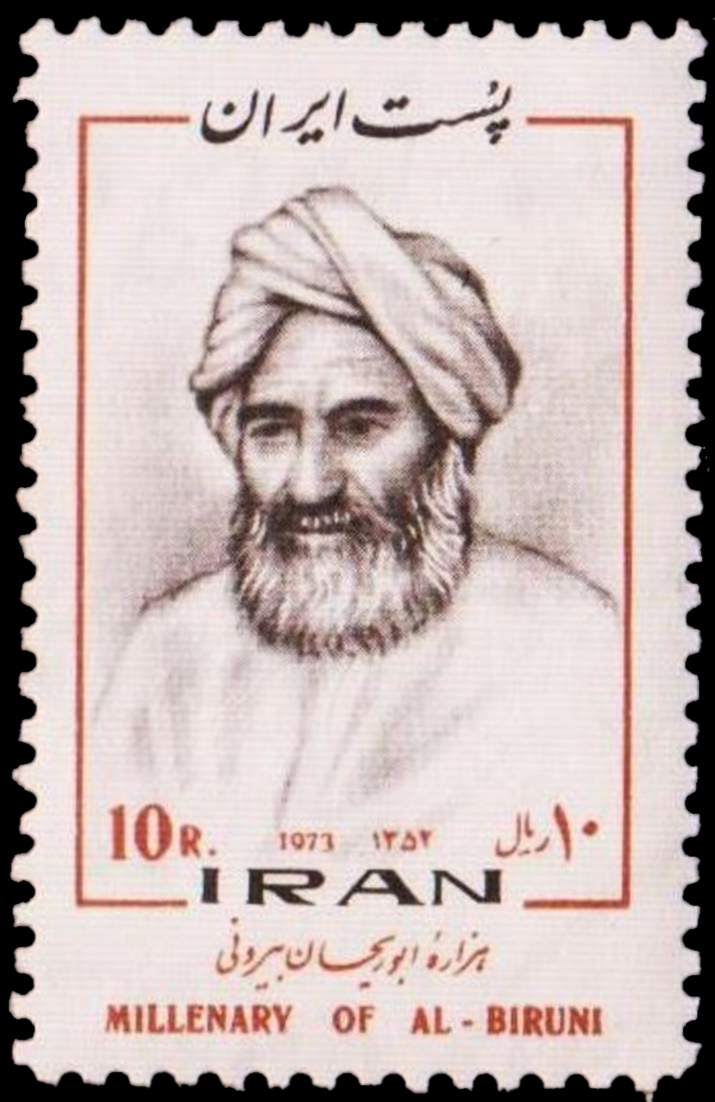 |
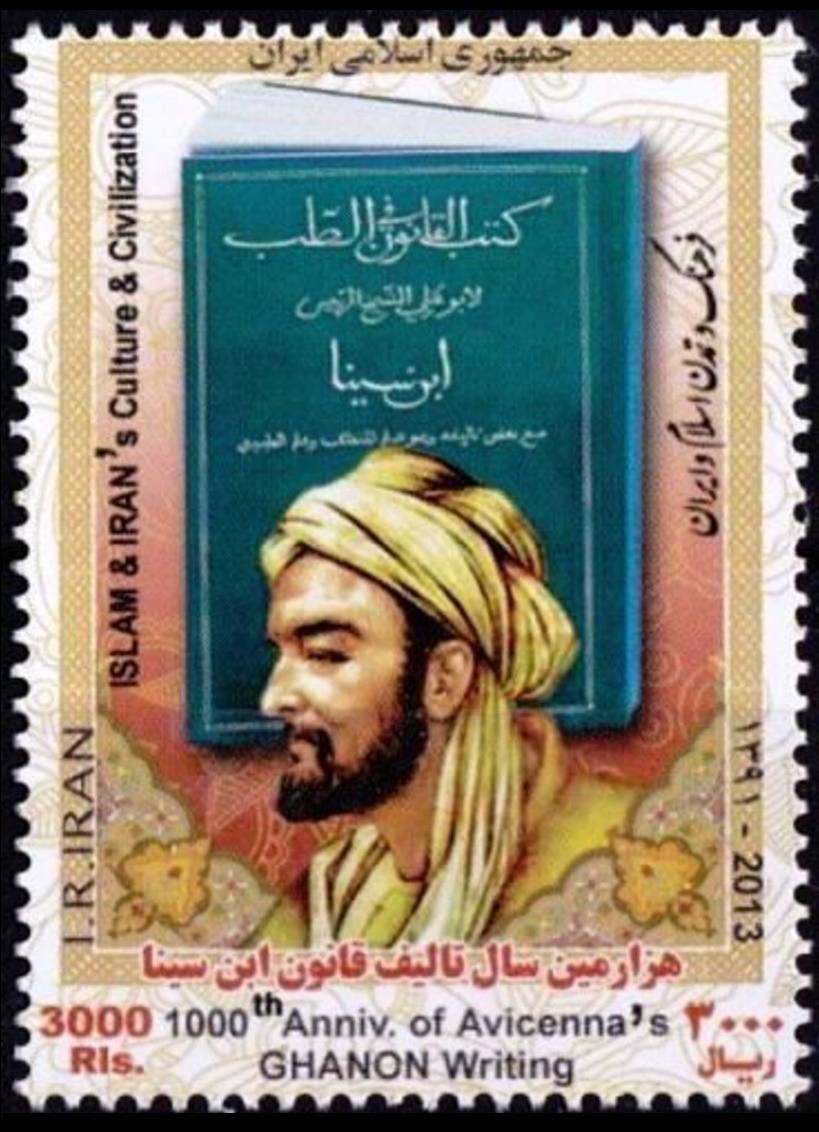 |
 |
| Al-Biruni on stamp of Iran 1973 MiNr.: 1649, Scott: 1728. | Ibn Sina, known in the West as Avicenna on stamp of Iran 2013 MiNr.: 3303, Scott: . | Shen Kuo on stamp of China 1962 MiNr.: 671, Scott: 643. |
The Greek historian Herodotus (c. 484 – 425 BCE) also observed fossilized seashells and marine remains in the mountains of Egypt and Libya. He suggested that these regions were once covered by seawater, supporting the idea that the landscape had undergone significant changes over time.
The Greek philosopher Empedocles (c. 495 – 435 BCE) proposed that land and sea had exchanged places multiple times in Earth's history. While his theories were more mythical than scientific, they reflected an early awareness that marine fossils found in mountains could indicate a dramatic transformation of Earth's surface over long periods.
Genesis and Stability of Species
With the rise of Christianity across Europe, much of the ancient scientific knowledge faded into obscurity. The dominant explanation for the natural world shifted to one of Divine creation, as described in the Bible: God created the Earth and all living things, with each species designed for a specific purpose in nature.In contrast, scholars in the East maintained a more scientific approach. Thinkers such as al-Biruni (973 - 1048) and Avicenna (980 - 1037) in Iran, and Shen Kuo (1031 - 1095) in China correctly identified fossils as remains of ancient animals and plants.
Meanwhile, many naturalists in the Christian world misinterpreted fossils, often viewing them as relics of biblical giants, mythical beasts, or simply oddly shaped stones - a phenomenon sometimes called “the game of Nature”. A common belief among some clergy was that God had placed bones in rocks to test humanity’s faith in the Genesis account.
In 1620, James Ussher (1581 – 1656), Archbishop of Armagh and professor at Trinity College Dublin, famously calculated, using biblical chronology, that the Earth was created in 4004 BCE, making it about 6,000 years old. This view would influence Christian doctrine and natural philosophy for centuries.
 |
| Miocene salamander Andrias scheuchzeri on Maxi Card of Switzerland 1959 |
 |
| The dragon fountain of Klagenfurt on commemorative postmark of Austria 1968 |
 |
| Johann Jakob Scheuchzer on commemorative postmark of Switzerland 1977 |
- Around 1335, a large, unidentified skull was discovered near
Klagenfurt, Austria.
Locals, unfamiliar with prehistoric animals, believed it to be the skull of a dragon, a creature deeply embedded in regional folklore. -
In 1443, during the construction of the north tower of St. Stephen’s Cathedral in Vienna,
Austria, workers uncovered a massive bone, later identified as the femur of a
woolly mammoth (Mammuthus primigenius).
The bone was thought to be the relic of a biblical giant and was prominently displayed on the cathedral’s north gate, which came to be known as the Giant’s Gate (Riesentor). - In 1577, near the monastery of Reiden in Switzerland, mammoth bones were unearthed and thought to be the remains of a giant who had once lived in the area.
- In 1726, Swiss naturalist Johann Jakob Scheuchzer (1672 – 1733) described the fossil of a large,
one-meter-long Miocene salamander, later named Andrias scheuchzeri in his honour.
At the time, however, Scheuchzer believed the fossil to be the remains of a human who had drowned during the biblical Flood.
16th and 17th Centuries - Recognition of Fossils as Remains of Living Organisms
 |
|
| Bernard Palissy on stamp of France 1957, MiNr.: 1137; Scott: B313. | |
 |
|
 |
|
| Nicolas Steno and the shark teeth on stamps of Denmark 1969 and 1998 respectively. MiNr.: 485, 1196; Scott: 462, 1107. | |
Based on his own observations, Palissy noted that the shapes and intricate structures of fossilized shells and bones were far too precise and biologically accurate to be anything other than the remnants of once-living creatures. He also suggested that these remains had been buried in sediments and hardened over time - a remarkably advanced idea for the 16th century.
His ideas were published in his major work, "Discours Admirables" (1580), where he wrote about natural history, Geology, and Hydrology, emphasizing the importance of first-hand observation:
I am of the opinion that these are truly the remains of sea creatures, and that they were once living,
for one sees in them all the natural characteristics of the creatures they resemble.
In 1667, the Danish scientist and Catholic bishop, who was trained as doctor and had a strong interest in anatomy, Nicolas Steno (1638 – 1686) published "Canis Carchariae Dissectum Caput" ("A Dissected Head of a Shark of the Species Carcharias"), a work in which he made a ground-breaking observation that would lay the foundation for modern Paleontology and Geology.
After completing his university studies in Copenhagen, Steno began traveling across Europe before settling in Italy in 1666. He initially served as a professor of anatomy at the University of Padua, and later became the personal physician to Grand Duke Ferdinando II de' Medici in Florence, a notable patron of the arts and sciences whom Steno had previously met in Pisa.
While dissecting the head of a shark caught near Livorno, Italy, in the previous year, Steno noticed a striking resemblance between the shark’s teeth and the widely known “tongue stones” - fossilized objects long believed to hold magical or mystical properties. Traditionally, these stones, found in many parts of Europe, but were especially common in Malta, were thought to possess magical or healing powers. Some legends claimed they were the petrified tongues or snakes punished by saints, while others believed they had fallen from the moon. Many people used them as talismans or remedies for various ailments.Steno firmly rejected the long-held belief that "tongue stones" could form spontaneously within solid rock under the influence of cosmic or mysterious forces. He compared them to crystals, which can grow within the Earth and whose formation can be reproduced in laboratory conditions. Crystals, however, have a simple and regular structure, unlike the intricate anatomy of "tongue stones". This comparison led Steno to a revolutionary conclusion: the "tongue stones" were actually fossilized shark teeth, and fossils in general were the remains of once-living organisms.
His insight challenged centuries of myth-based interpretation and helped establish fossils as scientific evidence of Earth’s biological and geological history.
Steno also explored the cliffs and hills of Italy, seeking to understand the Earth’s structure. He proposed that all rocks and minerals had originally existed in a fluid state and gradually settled out of ancient oceans, forming successive horizontal layers. These layers, new sediment atop older strata, occasionally became interrupted by molten intrusions, which created new rock formations. As sediment built up, it could entomb organisms, preserving them as fossils within the rock record.
Steno’s observations led to the development of the following laws.
- "Law of Original Horizontality" - layers of rock were deposited as horizontal sheets.
-
"Law of Lateral Continuity" - layers of rock extend in all directions away
from their source until they
- either run out of sediment to the build the layer out further or
- run into a barrier such as the walls of the valley
- "Law of Superposition" - the principle that in any undisturbed sequence of sedimentary rock layers, the oldest layers lie at the bottom and the youngest at the top.
18th century - Binomial Nomenclature, Estimation of the Earth’s age, and Early Ideas on Animal Distribution
In 1735, the Swedish biologist and physician Carl Linnaeus (1707–1778) published the first edition of his most influential work, Systema Naturae. In this ground-breaking publication he introduced binomial nomenclature, the modern system used to name living organisms.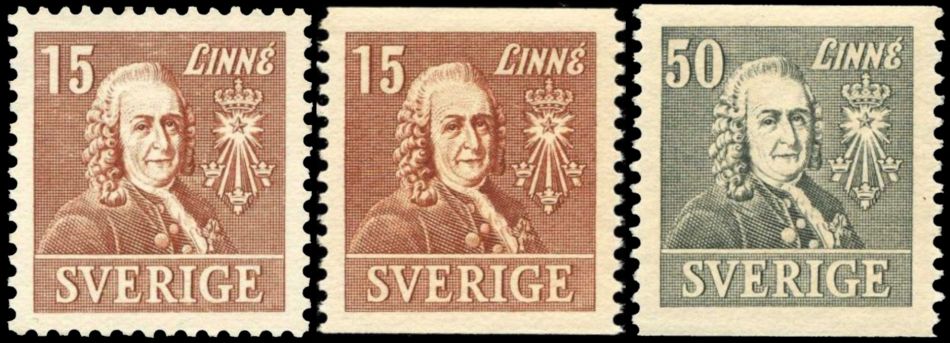
The first stamps of Carl Linnaeus - Sweden 1939, MiNr.: 273 A-B, 275A; Scott: 294, 296, 298.
The tenth edition of the book, issued in Stockholm in 1758, is regarded as the official starting point of zoological nomenclature. Linnaeus later released a greatly expanded 12th edition between 1766 and 1768, the last one published under his authorship.
In Systema Naturae, Linnaeus presented his vision for a hierarchical classification of nature, dividing the natural world into three kingdoms:
- the animal kingdom (regnum animale),
- the plant kingdom (regnum vegetabile),
- the mineral kingdom (regnum lapideum).
For the first time in scientific history, humans were grouped together with other primates under the name Anthropomorpha. He further divided humans into four varieties, based on skin color, each aligned with one of the four known continents and corresponding temperaments. Another very important work by Linnaeus, "Species Plantarum", was published in 1753. Together, the first edition of "Species Plantarum" (1753) and the tenth edition of "Systema Naturae" (1758) are recognized as the official foundations of modern biological nomenclature.
Linnaeus introduced a standardized method of naming organisms using a two-part Latin name: genus and species, such as Megaloceros giganteus or Mammuthus primigenius.
This innovation created a universal scientific language for Biology that remains in use today.
He also developed a system of organizing life into nested hierarchical categories: Kingdom, Class, Order, Genus, Species, to reflect the perceived relationships among organisms. While Linnaeus originally intended this framework to demonstrate the divine order of creation, it later became a powerful tool for understanding Evolutionary relationships.
Although Linnaeus was not an evolutionist, his classification system and the concept of natural groupings of organisms were instrumental in the development of evolutionary Biology. Charles Darwin and others drew heavily from Linnaean taxonomy when formulating the theory of common descent and the concept of the tree of life, which envisioned life’s diversity as branching from shared ancestors.
In 1778, the French naturalist Georges-Louis Leclerc, Comte de Buffon (1707 – 1788) conducted one of the first scientific experiment to estimate the age of the Earth. This work formed part of his monumental 36-volume series "Histoire Naturelle" published between 1749 and 1788.
 |
| Georges Buffon on stamp of France 1949, MiNr.: 874; Scott: B241. |
To test this hypothesis, Buffon conducted a practical experiment. He heated iron spheres of various sizes until they glowed red-hot and then placed them in a cave to cool, simulating the Earth’s gradual loss of heat. By measuring how long each sphere took to reach ambient temperature, he extrapolated that a body the size of Earth would take approximately 75,000 years to cool from a molten state - a figure that vastly exceeded the widely accepted 6,000-year Biblical chronology. Building on this deep timescale, Buffon argued that life must also have a history. This view challenged the prevailing belief that all species were divinely created in their present forms and roles, with no need for change or development.
Buffon went further, proposing that life could arise spontaneously under the right conditions. He speculated that in Earth’s early, scalding oceans, unorganized matter gave rise to vast quantities of life, even large animals, which he imagined could appear fully formed. As the planet cooled, he suggested, many of these organisms migrated toward the tropics, explaining why fossilized elephant remains were found in Siberia and North America, while living elephants existed only in Africa and South Asia. In his view, the Siberian form may have survived and evolved into the modern elephant, while the North American populations went extinct.
Initially, Buffon believed that life originated in the far north, such as Siberia, due to Earth’s presumed early heat. However, this theory faltered when fossil remains of mammoths (Mammuthus primigenius) were shown to differ anatomically from modern Indian and African elephants. Eventually, Buffon accepted that mammoths and mastodons were distinct, cold-adapted relatives of modern elephants, rather than their direct ancestors
 |
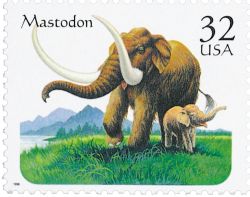 |
 |
 |
| Woolly mammoth on stamp of Switzerland 2024 MiNr.: 2970, Scott: 1989. | Mastodon on stamp of USA 1996 MiNr.: 2737, Scott: 3079. | African elephant on stamp of Tanzania 1988 MiNr.: 428, Scott: 388. | Asian elephant on stamp of Bangladesh 1977 MiNr.: 98, Scott: 134. |
During his studies of the natural world, Buffon observed that regions with similar climates often supported very different assemblages of plants and animals - a concept now known as Buffon’s Law, regarded as the first principle of Biogeography.
He proposed that, after dispersing from a single “center of creation” species could both improve and degrade in form, directly contradicting the biblical concept of Genesis.
 |
| Buffon's statue (located in the botanical garden of the Natural History Museum at Paris) is on the salvages of personalized Mini-Sheet of France from 2016. |
During Buffon's lifetime, many speculated that apes were simply inferior humans, degenerate children of Adam.
However, Buffon, unusually for his time, rejected the idea that Europe was humanity’s birthplace. While he recognized that human populations could change over time, he did not believe humans had descended from other animal species. Instead, he thought each species began as its own prototype, capable of undergoing modifications, with some characteristics overlapping among species.Buffon was also one of the first naturalists to describe ecological succession — the sequential change of biological communities over time.
Because his ideas on deep geological time and species transformation conflicted with the literal Biblical narrative of creation, the theology committee at the University of Paris pressured him to recant his theories about geological history and animal evolution.
Nevertheless, in later editions of "On the Origin of Species, Charles Darwin acknowledged Buffon as "the first author who in modern times has treated [evolution] in a scientific spirit".
18th and 19th Centuries - First Extinction Theories and the Description of Prehistoric Animals
 |
| Geological map of Ireland on stamp from 1995, MiNr.: 908, Scott: 978. |

|
| William Smith (1769 - 1839), the "Father of English Geology". |
The increasing importance of mining in Britain made accurate knowledge about ores and their natural distribution crucial. This demand spurred the rapid development of the science that studies the Earth’s materials — what we now call Geology.
To meet the growing need for coal, iron, and other minerals, early geologists began producing geological maps to show the distribution of different rock types across various regions.
One of the key pioneers of this effort was William Smith (1769 - 1839), a surveyor who spent six years supervising the construction of the Somerset Canal in southwestern England.
While excavating the canal, Smith closely observed the exposed strata (the horizontal layers of rock) and became deeply familiar with their sequence. He noticed a consistent pattern: fossils embedded in these layers (strata) always appeared in the same vertical order, with the oldest at the bottom and the youngest at the top. As he travelled throughout England, Smith observed this pattern of fossil succession was repeated wherever he went.
From these observations, he deduced that each fossil species existed for a specific time period during Earth's history and that their stratigraphic order could be used to compare the ages of rock formations across regions. Around 1799, while working on his geological maps, Smith formulated the Principle of Faunal Succession:
Fossil organisms succeed one another in a definite and recognizable order, so that rocks containing similar fossils are of a similar age, even if they are found in different locations.
This principle allowed him to date and correlate rock layers (strata) using their fossil content, laying the groundwork for the modern science of Biostratigraphy. In 1815, William Smith published the first geological map of England, a landmark in Earth science that vividly illustrated the distribution of rock layers and their fossil content across the country. For his pioneering work in correlating strata through fossil evidence, Smith is rightfully celebrated as the "Father of English Geology".Today, such fossils are known as "index fossils". This term was introduced in 1851 by two American paleontologists Fielding Bradford Meek (1817 - 1876) and Amos Henry Worthen (1813 - 1888).
Index fossils are the preserved remains of organisms that lived during a relatively short geological time span, were geographically widespread, and are easily recognizable. They are crucial for dating and correlating rock layers across different regions.
The most important ones are trilobites, ammonites, brachiopods and foraminifera (Planktonic forms). Some index fossils are microscopic and are studied within the specialized field of Micropaleontology. |
 |
 |
 |
 |
| Trilobite on postage stamp of Slovenia 2000,
MiNr.: 295; Scott: 397. |
Ammonite on postage stamp of Luxembourg 1984,
MiNr.: 1109; Scott: 716. |
Brachiopod on postage stamp of the British Antarctic Territory 1990,
MiNr.: 157; Scott: 154. |
Radiolarian, closely related to foraminifera on postage stamp of Norway 2005, MiNr.: 1553; Scott: 1449. | Micropaleontology on postage stamp of Tunisia 1974, MiNr.: 831; Scott: 627.
|
As miners dug ever deeper to meet the growing demand for ores and minerals, they began unearthing increasingly unusual rocks and fossilized remains.
 |
| Miners dug for ores and minerals on postmark of German Democratic Republic 1965, MiNr.: 1143; Scott: 797. |
At the time, nearly all scholars accepted a Divine Creation of Earth and its inhabitants, making the concept of extinction deeply troubling.
How could any organism created by God go extinct?
Why would God allow it to vanish from the Earth?
Lacking a scientific explanation, many fossil remains were interpreted in various ways: some as belonging to still-living animals such as crocodiles, others as victims of the Biblical Flood, or even as the bones of legendary giants.
It was not until 1835, with the founding of the British Geological Survey, the world’s first national geological survey, that systematic study of Earth’s history truly began.
By the early 1800s, however, a handful of naturalists had already begun advancing bold new ideas about the origins and transformations of life, setting the stage for the development of modern Geology and evolutionary theory.
Catastrophism
One of the earliest explanations for extinction was provided by Georges Cuvier (1760 - 1832), a French naturalist and zoologist, often referred to as the "Founding Father of Paleontology". |
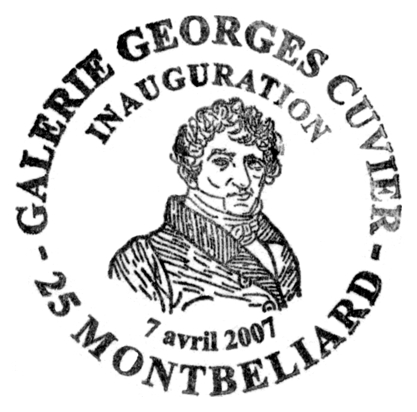 |
| Georges Cuvier on postmarks of France 1969 and 2007. | |
By comparing fossil assemblages across different rock layers, Cuvier recognized multiple distinct extinction events and concluded that the Earth must be millions of years old. This view directly contradicted the Church's claim that the Earth was only six thousand years old. Influenced by the rational spirit of the French Revolution, Cuvier consciously avoided religious or metaphysical explanations in his scientific work.

|
| Charles Lyell in 1840 (about the same time he met Charles Darwin for the first time). Image credit: Wikimedia. |
Charles Darwin's geological observations during his
voyage aboard HMS Beagle were
heavily influenced by Charles Lyell’s "Principles of Geology", published in 1830,
a copy of which was given to him by Captain FitzRoy.
Inspired by Lyell’s theory of uniformitarianism, which argued that slow, gradual processes shaped
the Earth over immense timescales, Darwin carefully examined geological features throughout his journey.
In South America, he observed fossilized marine shells high in the Andes, suggesting that the mountains had been uplifted over time.
On the coast of Chile,
he witnessed an earthquake that raised the land, providing direct evidence of Lyell’s ideas in action.
These experiences helped Darwin appreciate the vast age of the Earth and the cumulative power of
small changes over long periods—concepts that became central to his later evolutionary thinking.
Lamarckism
In 1800, four years after Georges Cuvier introduced his theory of Catastrophism, another French scientist proposed a radically different idea, Jean-Baptiste Lamarck (1744 – 1829), a French naturalist, biologist, academic, and soldier, outlined what would later be known as Lamarckism during a lecture on invertebrate zoology at the French National Museum of Natural History.He developed these ideas in print in "Philosophie Zoologique" (1809) and later in the introduction to his „Histoire Naturelle des Animaux sans Vertebres“ (1815).
Lamarck argued that all species, including humans, had descended from earlier, simpler forms, evolving gradually over time.
 |
 |
| Jean Baptiste Lamarck on postmarks of France 1989 and 1979. | |
Lamarck’s most famous contribution was his theory of the inheritance of acquired characteristics. He believed that organisms adapted to their environments through use and disuse of their organs: organs exercised frequently became stronger and more developed, while those used less often weakened or disappeared. For example, he suggested that moles lost their eyesight due to disuse, birds lacked teeth from not using them, and mammals developed certain features through repeated use. Lamarck argued that these “acquired” traits, developed during an individual’s lifetime, were then inherited by its offspring. Over time, the accumulation of such inherited traits would lead to significant morphological changes.
Lamarck’s classic giraffe example involved giraffes: he proposed that ancestral giraffes, were originally short-necked like other herbivores, stretched their necks to reach high leaves. This repeated effort gradually lengthened their necks during their lifetimes, and these longer necks were then inherited by their offspring. Over many generations, this led to the evolution of the modern long-necked giraffe.
 |
 |
 |
 |
 |
| Prehistoric giraffids (short neck): Giraffa punjabiensis and Giraffokeryx punjabiensis on postage stamps of Nepal 2013 and 2017 respectively, MiNr.: 1123, 1252; Scott: 940, 1049. |
Modern giraffe (long neck): Giraffa camelopardalis on stamps of
Tanzania 1985 MiNr.: 168C, Scott: .
Equatorial Guinea 1974, MiNr.: 478, Scott: .
Poland 1972, MiNr.: 2163, Scott: 1889.
|
|||
Lamarck’s theory was ground-breaking in suggesting that species were not fixed, but could adapt and change over time to their environment. He was one of the first naturalists to propose that organisms could change in response to their environment, and that such changes could accumulate across generations, rather than existing exactly as they had been created, as claimed by the Church. However, modern genetics has since disproven the mechanism Lamarck proposed. We now understand that traits acquired during an individual’s lifetime, such as increased muscle mass or a stretched neck, are not passed down through DNA and therefore cannot be inherited by offspring. Despite this, Lamarck remains an important historical figure in evolutionary thought, as his work laid the groundwork for later theories, including Darwin’s theory of natural selection.
Homology
In 1822, the same year the term Paleontology was coined in France, Etienne Geoffroy Saint-Hilaire (1772 – 1844), a French naturalist and supporter of Lamarck, expanded on Lamarck’s evolutionary ideas. Geoffroy championed the concept of an underlying unity of organismal design and the possibility of species transmutation over time. Drawing from Comparative Anatomy, Paleontology, and Embryology, he argued that natural laws, not divine intervention, governed the development of life.Though Geoffroy personally believed in God, he viewed the universe as being structured by consistent natural principles. In his "Anatomical Philosophy", he highlighted structural similarities across very different organisms. For example, he noted that the bat’s wing, the lungfish’s fin, and the human hand all share a common skeletal framework and occupy similar positions within the body plan. These observations suggested a fundamental anatomical unity, what would later be understood as Homology.
 |
 |
| Structure of arm of different animals on postage stamps of North Korea 1999, MiNr.: Bl. 423; Scott: 3863. | Geoffroy Saint-Hilaire Etienne. |
At the time, however, Geoffroy’s and Lamarck’s ideas, that nature could generate complex life autonomously, without Divine guidance, were considered heretical by most of Europe’s scientific and religious establishments. As a result, both were widely criticized and their theories rejected.
More than two decades later, in 1843, British anatomist Richard Owen (1804–1892), best known for coining the term dinosaur in 1841, formalized the concept of Homology. He defined it as “the same organ in different animals under every variety of form and function”. Owen’s examples included the bat’s wing, the whale’s flipper, and the human arm, structures that differ in appearance and use, but are constructed from the same fundamental anatomical elements.
Following the publication of Charles Darwin’s "On the Origin of Species" in 1859, Owen’s concept of Homology was reinterpreted within the framework of common descent. Darwin argued that homologous structures provided powerful evidence for evolution: they indicated that seemingly different species had inherited a common anatomical blueprint from a shared ancestor, with modifications accumulating over time through natural selection.
Description of the First Prehistoric Animals
 |
| Everard Home (1756 – 1832) curator of the Department of Natural History British Museum. Image credit: Wikimedia. |
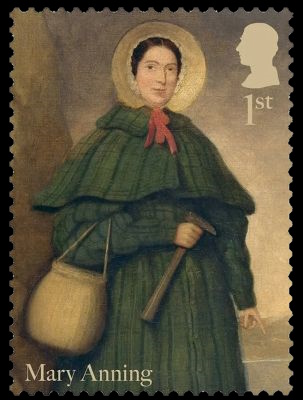 |
| Mary Anning on stamp of UK 2024, MiNr.: 5391, Scott: 4484a. |
The fossil described by Home had been discovered years earlier, in 1811–1812, by Mary Anning (1799–1847) and her brother Joseph Anning (1796–1849), then just teenagers, which consisted of a complete skull and a partial torso.
Three years later, in 1817, the creature was formally named Ichthyosaurus, meaning "fish lizard", by Charles Dietrich Eberhard Koenig (1774 - 1851) curator of the Department of Natural History British Museum, based his classification on a different specimen.
At the time, many people still believed such fossils were not the remains of once-living beings, but rather “sport of nature” - stone formations placed in rocks by God to test human faith. Skepticism persisted until more evidence emerged.
In 1835, the British Museum purchased an a nearly complete Ichthyosaurus skeleton from Mary Anning with the coprolite (fossilized feces) within its ribcage. The presence of fossilized excrement was clear proof that the animal had once lived, eaten, and digested food—unmistakable signs of a real biological organism. Only living animals produce feces, and this confirmation helped shift scientific opinion toward accepting fossils as evidence of prehistoric life.
Some historians of science have suggested that Mary Anning’s discoveries may have indirectly influenced Charles Darwin in his development of Evolution theory.
In 1823, Anning made another groundbreaking discovery: the first complete skeleton of a Plesiosaurus, a long-necked marine reptile unlike any known creature. When the French naturalist Georges Cuvier, a leading authority on extinct animals, saw an early sketch of the fossil, he suspected it was a hoax, a composite of two different animals, either deliberately or mistakenly assembled. He doubted that any animal could have a neck longer than its body. However, upon reviewing more detailed drawings and further evidence, Cuvier acknowledged its authenticity.
Impressed, he mentioned Anning by name in his 1824 work "Recherces sur les ossemens fossiles", a rare recognition for a working-class woman in science at the time. By the mid-1820s, Anning’s contributions began to gain broader recognition among scientists, and her fossils helped establish paleontology as a serious field of inquiry.
 |
 |
 |
 |
| Prehistoric marine reptiles: Ichthyosaur, Plesiosaur and Plesiosaurus, described in 1830s by English naturalists, based on fossils discovered by Mary Anning, on stamps of the Royal Mail from 2013 and 2024 | |||
Ichthyosaurs and Plesiosaurus were not the only prehistoric animals that puzzled 19th century scientists.
Meanwhile, in 1824, another pivotal fossil discovery added to the growing catalogue of prehistoric life. William Buckland (1784 - 1856), Professor of Geology at the University of Oxford and Dean of Christ Church, described the jaw and other bones unearthed decades earlier in in Oxfordshire. Although unsure of the creature’s precise nature, Buckland speculated that it might have lived both on land and in water. He named it Megalosaurus (“great lizard”), making it the first extinct species later recognized as a dinosaur to be formally described in scientific literature.
 William Buckland and the Megalosaurus jaw on postmark of South Korea 2001.
William Buckland and the Megalosaurus jaw on postmark of South Korea 2001.
When Buckland, Professor of Geology at the University of Oxford, realized, from the shape of its teeth, that Megalosaurus was carnivorous, he found himself in a difficult position.
 |
 |
| The jaw of the Megalosaurus | Megalosaurus on one of the "Dinosaurs" stamps of UK 2013, MiNr.: 3534, Scott: 3236. |
The University of Oxford, one of the world’s oldest and prestigious universities, was established in the 12th century, with teaching beginning around 1096. As the oldest university in the English-speaking world, Oxford was originally founded to educate clergy and scholars in theology, philosophy, and the liberal arts. By the 19th century, religious influence at Oxford remained deeply entrenched. Science at the time was often expected to support and confirm the biblical account of creation. Professors who publicly taught ideas that contradicted scripture risked professional censure or even expulsion from the university.
According to Christian doctrine, carnivorous animals were associated with violence, and evil had only begun on Earth with human decadence — with original sin. Before Adam and Eve's original sin, all creatures were thought to have lived peacefully in the Garden of Eden. Violence, death, and predation were viewed as postlapsarian evils, incompatible with the idea of a benevolent Creator. How then could a flesh-eating predator like Megalosaurus, built to kill, fit into the divine plan?Buckland, who had previously spent much of his early career trying to demonstrate the reality of Noah’s Flood through geological evidence, offered a theological justification. He argued that Megalosaurus was a “perfect killing machine”, capable of dispatching its prey quickly and efficiently, thereby minimizing suffering in the natural world. This justification allowed Buckland to uphold his faith while acknowledging the brutal reality of prehistoric life. If death was inevitable in nature, then mercy could still exist in the swiftness of death.
 |
 |
| Gideon Mantell and his wife study Iguanodon teeth on postmark of China 2005 | Iguanodon on one of the "Dinosaurs" stamps of UK 2013, MiNr.: 3528, Scott: 3230. |
In 1833, Mantell described another prehistoric animal and named it Hylaeosaurus meaning "belonging to the forest lizard", later recognized as one of the earliest known ankylosaurs, a group of heavily armoured dinosaurs.
These three previously unknown to science creatures were grouped into new suborder of the Saurian Reptiles in 1841 by the Anatomy Professor of the British Museum Richard Owen, who called them “Dinosaurs” meaning “terrible lizards”.
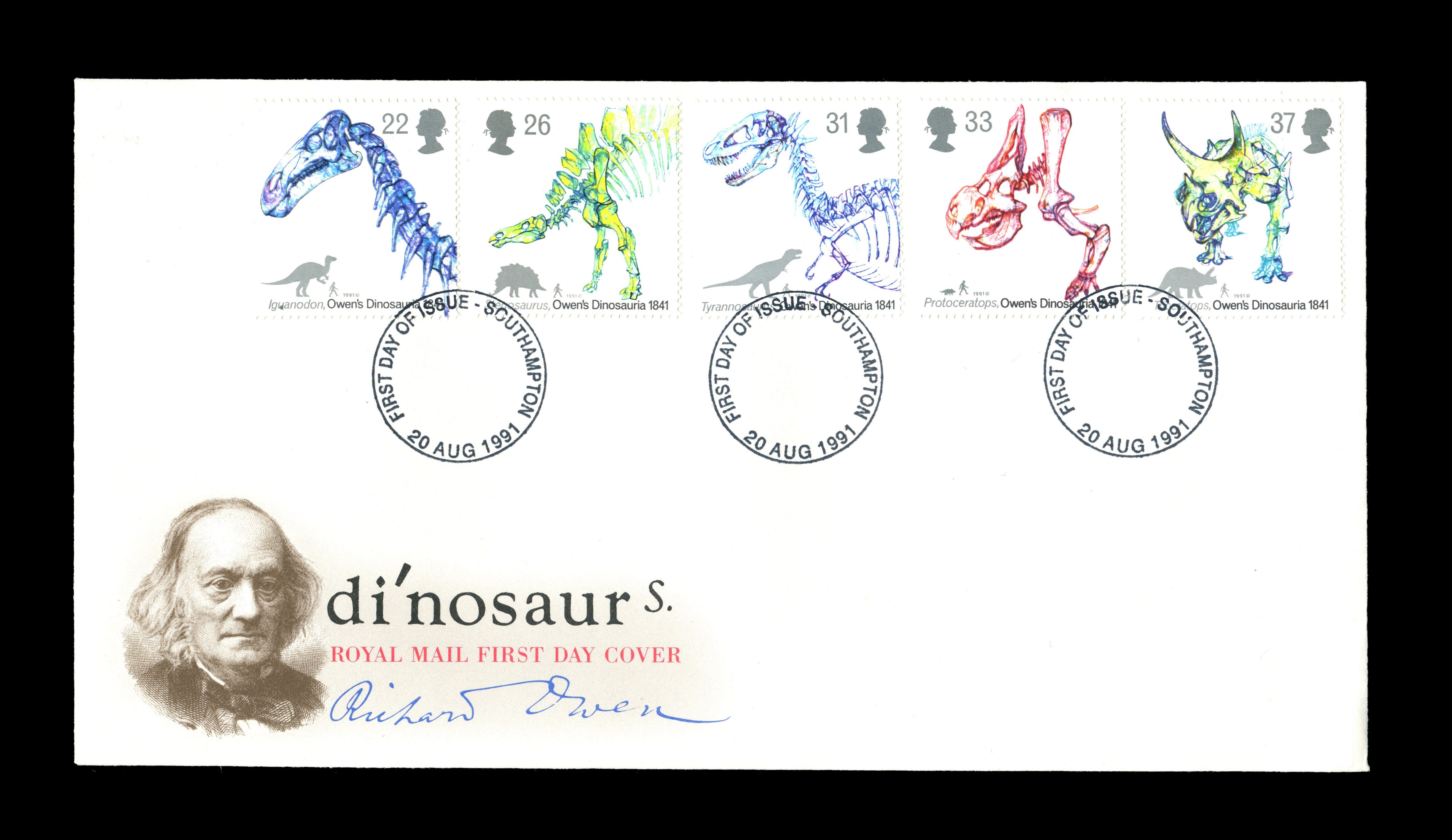
FDC "150th anniversary of Dinosaurs' identification by Sir Richard Owen", Great Britain 1991.
Embryology
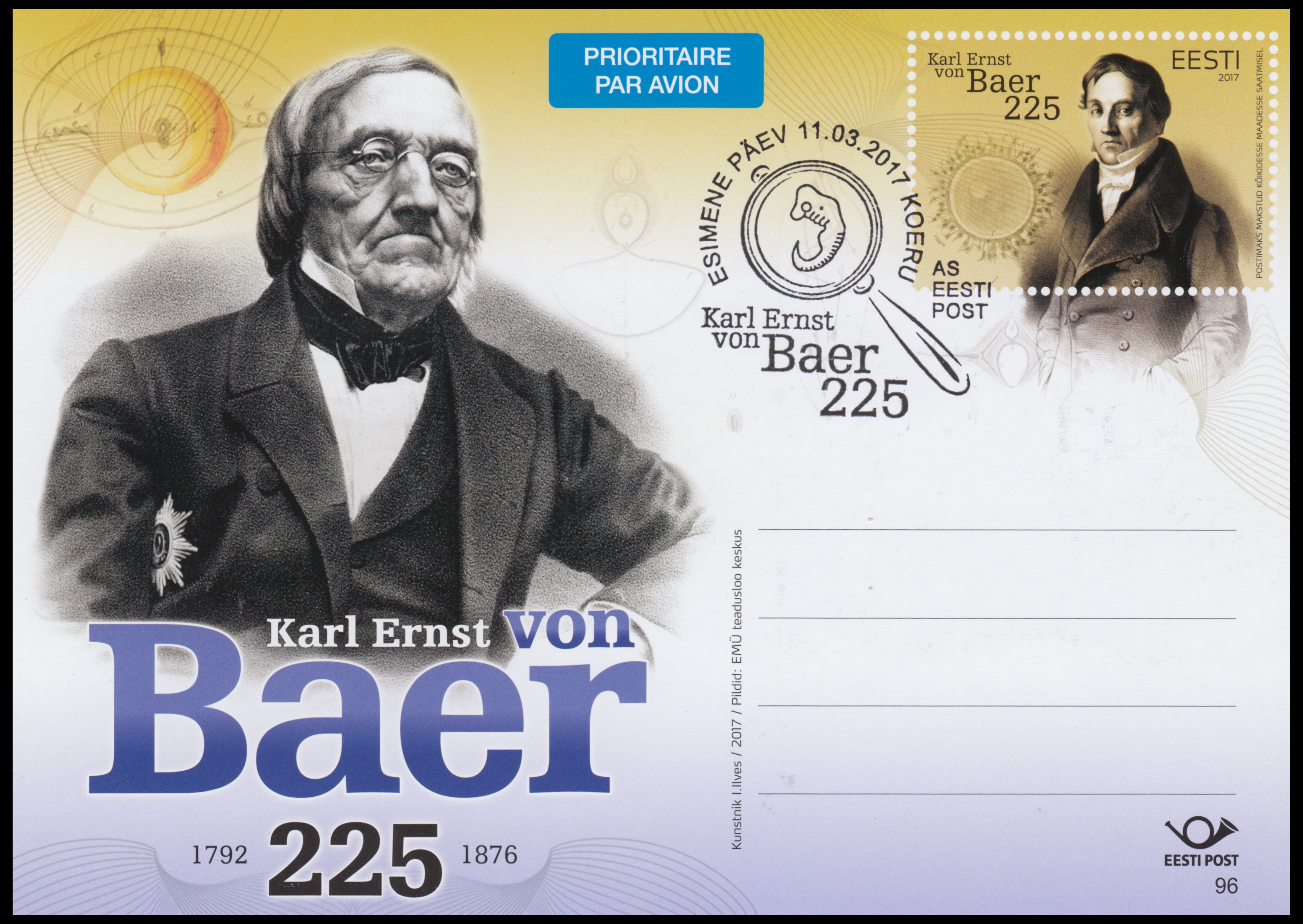 |
| Karl Ernst von Baer on postal stationery of Estonia 2017. |
Von Baer established several foundational principles of embryonic development.
- General to specific progression. Embryos start from a generalized form and gradually develop more specialized structures as they mature.
- Similarity among related species. Closely related species share early embryonic stages, diverging only later in development.
- Rejection of recapitulation. He refuted the then-popular notion, often misattributed to evolutionary theory, that embryos of one species pass through the adult stages of others (the idea of “ontogeny recapitulates phylogeny”)
Natural Selection

|
| Patrick Matthew (1790 – 1874), who formulated a theory of natural selection, nearly three decades before Darwin. Image credit: Wikimedia. |
In the appendix of his book "On Naval Timber and Arboriculture", Matthew outlined a mechanism by which the most robust or best-adapted individuals survive, while less-suited ones perish, an early articulation of the concept of natural selection. He also proposed that environmental pressures and competition could lead to extinction of species and their replacement by better-adapted forms over time.
Darwin was unaware of Matthew’s work when writing the first edition of "Origin of Species" (published in 1859).
In 1860, after publication, Matthew wrote a letter to a journal pointing out that he had published the same core idea decades earlier.
Darwin graciously acknowledged Matthew’s priority in later editions of "Origin", adding him in the “Historical Sketch” section,
although he noted that Matthew’s work had received little attention and had not influenced the scientific community or his own research:
“Mr. Patrick Matthew... published in 1831 a work on Naval Timber and Arboriculture, in which he gives precisely the same view on the origin
of species as that propounded by Mr. Wallace and myself... Unfortunately, the view was given very briefly in scattered passages.”
Theory of Evolution by Charles Darwin
 |
| The first stamp of Charles Darwin was issued by Ecuador in 1936, MiNr.: 351; Scott: 345. |
In the book, Darwin proposed that species change over time through a process he called Natural Selection. According to this theory, individuals with traits better suited to their environment are more likely to survive and reproduce, passing those advantageous traits to their offspring.
Importantly, this did not necessarily mean the strongest or fastest individuals, but those whose physical or behavioural characteristics gave them a survival advantage in a particular environment.
Darwin’s theory challenged long-held beliefs about the permanence of species and the direct creation of life as described in religious texts. He supported his arguments with extensive observations and evidence gathered during his five-year voyage aboard HMS Beagle, particularly from regions like the Galapagos Islands.
Despite initial controversy, especially from religious institutions, Darwin’s theory gradually gained acceptance, reshaping not only Biology, but also Geology, Paleontology, Anthropology, and Ecology. To this day, Darwin’s central concept of evolution by natural selection remains a cornerstone of modern Biology. It underpins research in genetics, evolutionary developmental biology (evo-devo), Paleoanthropology, and many other scientific fields, continuing to deepen our understanding of the diversity and history of life on Earth.
References
|
|

|
Acknowledgements:
- Many thanks to Dr. Peter Voice from Department of Geological and Environmental Sciences, Western Michigan University, for reviewing the draft page and his very valuable comments.

